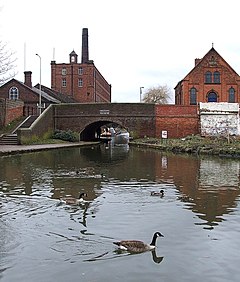Fazeley
| Fazeley | |
|---|---|
 Fazeley Junction |
|
| Fazeley shown within Staffordshire | |
| Population | 4,388 |
| OS grid reference | SK2002 |
| Civil parish |
|
| District | |
| Shire county | |
| Region | |
| Country | England |
| Sovereign state | United Kingdom |
| Post town | TAMWORTH |
| Postcode district | B78 |
| Dialling code | 01827 |
| Police | Staffordshire |
| Fire | Staffordshire |
| Ambulance | West Midlands |
| EU Parliament | West Midlands |
| UK Parliament | |
Fazeley is a small town and civil parish in the District of Lichfield, Staffordshire, England. Fazeley is located on the outskirts of Tamworth and the civil parish of Fazeley also includes Mile Oak and Bonehill.
It sits astride the junction of the Birmingham and Fazeley Canal and Coventry Canal; at Fazeley Junction are a couple of multi storey mills. Fazeley is also adjacent to Drayton Manor, formerly the home of Robert Peel and now a theme park and zoo.
The First Annual Fazeley Festival and Mile Oak Mile Charity hop took place on 15 September 2007.
Sitting in the centre of Fazeley, the Town Hall opened in 1898 and was named the Victoria Memorial Hall, commemorating the diamond jubilee of Queen Victoria, and James Eadie paid for both the cost of its construction, £3,000, and the land on which it stands, having signalled his intentions in this respect in 1896.
James Eadie intended that the Hall should benefit the inhabitants of Fazeley and help to promote their welfare. His vision was that the Hall would be used for public meetings, lectures and concerts and contain reading rooms. He even speculated that technical classes might some day be held "for the better training of workmen in their several crafts and industries."
This vision became a reality, meetings of all descriptions took place and winter entertainments were regularly well attended. There was a library and a reading room, classes were held in gymnastics and cookery, and an Evening Continuation School in horticulture attracted over 40 youngsters. In later years, silent movies were presented here, too.
The name Fazeley in its various spellings is found in documents dating back to 1135. All suggestions concerning its derivation propose that it comes from early Saxon language most take its meaning to be pasture land or pleasant pasture but another authority suggests it is a corruption of the Anglo-Saxon faresleia which meant bulls pasture. The various spellings support this latter suggestion and certainly the land alongside the River Tame, being very flat, may well have been used for this purpose.
...
Wikipedia

